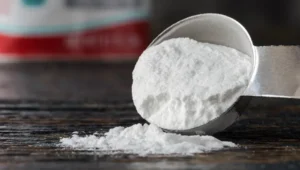- What baking soda is
- Safe and unsafe uses for dogs
- Symptoms of baking soda ingestion
- What to do if your dog eats it
- Safe alternatives
- Prevention tips
- What Is Baking Soda?
- Baking: Helps dough rise in bread, cakes, and cookies.
- Cleaning: Removes stains, odors, and grease.
- Deodorizing: Neutralizes smells in refrigerators, carpets, and shoes.
- Personal care: Found in toothpaste, deodorants, and skin products.
Is Baking Soda Safe for Dogs?
Safe Uses
- Bathing your dog: A small amount of baking soda in bathwater can help neutralize odors.
- Cleaning dog items: Baking soda can be used on bedding or toys, as long as it is rinsed thoroughly.
Unsafe Uses
- Feeding your dog baking soda: Even small amounts can cause serious health problems.
- Homemade toothpaste or treats: Avoid using baking soda in anything your dog can eat unless approved by a veterinarian.
Why Baking Soda Is Dangerous for Dogs

Symptoms of Baking Soda Poisoning
- Vomiting
- Diarrhea
- Loss of appetite
- Abdominal pain
- Lethargy or unusual tiredness
- Tremors or seizures (in severe cases)
- Increased heart rate or breathing difficulties
What to Do If Your Dog Eats Baking Soda
- Stay calm and try to estimate how much was eaten.
- Call your veterinarian or an emergency pet hotline immediately.
- Do not induce vomiting unless instructed by your vet. Vomiting may sometimes worsen the situation.
- Observe your dog for symptoms like vomiting, diarrhea, tremors, or lethargy.
- Follow your vet’s instructions carefully — your dog may need medical attention or monitoring.
Safe Uses of Baking Soda Around Dogs
- Bathing: Mix a small amount in warm water to neutralize odors.
- Cleaning: Sprinkle on dog bedding, toys, or crates and rinse thoroughly.
- Deodorizing: Remove carpet or fabric odors, but make sure the dog cannot lick it.
Uses to Avoid
- Never give baking soda as a remedy for dogs.
- Avoid sprinkling baking soda directly on your dog.
- Avoid using baking soda in homemade dog treats or toothpaste.
- Don’t leave baking soda in areas where your dog could eat it.
How Much Baking Soda Is Dangerous for Dogs?
- The dog’s weight and size
- Their overall health
- How much was ingested at once
Signs Your Dog May Be Affected
- Vomiting or gagging
- Loose stool or diarrhea
- Lethargy or weakness
- Trembling or shaking
- Loss of appetite
- Rapid breathing or heart rate
Puppies Are More Vulnerable
- Severe vomiting
- Diarrhea
- Dehydration
- Tremors or seizures
Safer Alternatives for Dogs
- Dog-safe shampoos: Formulated specifically for dogs’ skin.
- Diluted apple cider vinegar: Helps remove odor and is safe externally.
- Pet wipes: Convenient and safe for paws, fur, and face cleaning.
- Dog-friendly deodorizing sprays: Safe for bedding, crates, and toys.
How to Prevent Baking Soda Accidents
- Store baking soda in sealed containers out of your dog’s reach.
- Keep it off countertops or tables where your dog can sniff or jump.
- Supervise your dog during baths or cleaning activities involving baking soda.
- Educate family members and children about keeping baking soda away from pets.
When to Call the Vet
- Your dog eats a large amount of baking soda.
- Symptoms like vomiting, diarrhea, tremors, or lethargy appear.
- Your dog has pre-existing kidney, heart, or digestive problems.
- You’re unsure how much baking soda your dog ingested.
FAQ Section
1. Can dogs safely use baking soda for baths?
Yes, small amounts of baking soda mixed in water are safe for external use to reduce odor, but never allow dogs to ingest it.
2. What happens if my dog eats baking soda?
Eating baking soda can cause vomiting, diarrhea, stomach pain, lethargy, and in severe cases, tremors or seizures. Contact a vet immediately.
3. How much baking soda is toxic for dogs?
The toxic amount depends on your dog’s size, weight, and health. Even small amounts can be dangerous for puppies and small breeds.
4. Are there safer alternatives to baking soda for dogs?
Yes! Use dog-safe shampoos, diluted apple cider vinegar, pet wipes, or dog-friendly deodorizing sprays instead of baking soda.
5. How can I prevent my dog from eating baking soda?
Store baking soda in sealed containers, keep it out of reach, supervise your dog during cleaning or baths, and educate family members about its dangers.
6. When should I call the vet?
Call your vet immediately if your dog ingests baking soda, shows vomiting, diarrhea, tremors, or lethargy, or if you’re unsure how much was eaten.

